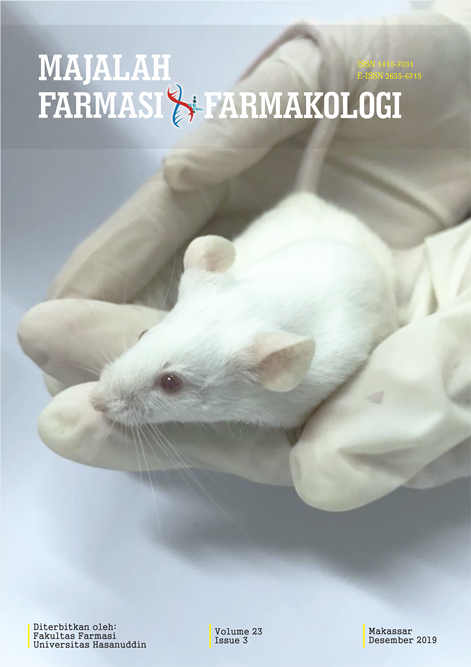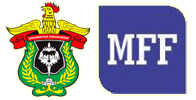PENGARUH KETINGGIAN TEMPAT TUMBUH TERHADAP AKTIVITAS ANTIOKSIDAN DAN SITOTOKSIK EKSTRAK RIMPANG LENGKUAS (Alpinia galanga L.)
Abstract
Rimpang Lengkuas (Alpinia galanga L.) merupakan tanaman yang telah banyak digunakan sebagai rempah dan obat tradisional dalam kehidupan sehari-hari. Tanaman ini mengandung senyawa bioaktif flavonoid yang memiliki efek antioksidan. Penelitian ini dilakukan untuk mengetahui pengaruh ketinggian tempat tumbuh terhadap aktivitas antiokasidan dan toksisitas dari ekstrak rimpang lengkuas (Alpinia galanga L.). Ekstraksi dilakukan dengan cara maserasi sedangkan kadar polifenol dan flavonoid total dilakukan dengan menggunakan metode Folin-ciocalteu dan metode kolorimetri yang dianalisis dengan menggunakan alat spektrofotometer UV-Vis. Uji aktivitas antioksidan dilakukan dengan menggunakan metode DPPH (2,2-Difenil-1-Pikrihidrazil) dan sitotoksisitas dengan menggunakan metode BSLT (Brine Shrimp Lethaly Test). Ekstraksi menggunakan pelarut etil asetat diperoleh rendemen sebesar 2,24% untuk dataran rendah, 3,51% dataran sedang dan dataran tinggi sebesar 3,77%. Analisis kadar fenolik dan flavanoid diperoleh berturut turut dari dataran rendah ke tinggi sebesar 6,08±0,26% dan 2,25±0,05%, 5,09±0,14% dan 1,09±0,08, 5,47±0,24% dan 1,16±0,3%. Aktifitas antioksidan yang tertinggi diperoleh pada dataran rendah diperoleh IC50 332,48 bpj, kemudian pada dataran tinggi dengan IC50 447,14 bpj dan pada dataran sedang diperoleh IC50 sebesar 518,57 bpj. Uji sitotoksik terhadap ketiga ekstrak menunjukkan hasil LC50 yang tidak terlalu berbeda antara ketiga lokasi tersebut.
References
Udin M. Environmental Factors on Secondary Metabolism of Medicinal Plants. Acta Scientific Pharmaceutical Science. 2019; 3(8), 34-46.
Laily AN, Suranto S. Characteristics of Carica Pubscens of Dieng Plateu, Central Java According to its Morphology, Antioxidant, and Protein pattern. Nusantara Biscience. 2012; 4(1), 16-21
Sholekah F. Perbedaan Ketinggian Tempat Tumbuh Terhadap Kandungan Flavonoid dan Beta Karoten Buah Karika (Carica pubescens) Daerah Dieng Wonosobo. Fakultas MIPA, Universitas Negeri Yogyakarta. 2017; 75-82
Subehan, Rifai Y, Mufidah. The Characterization and Anti-osteoporotic Activity of Sappan Lignum (Caesalpinia sappan L.) Extracts. International Journal of Phytomedicine. 2013, 5, 7-13.
Darmawan DA. Efektivitas Etanol Lengkuas Putih (Alpinia galangan L.Wild) Dalam Menghambat Pertumbuhan Candida albicans Secara In vitro. Fakultas Kedokteran Brawijaya; 2013
Yuslianti ER. Faramayuda F, Juliastuti H, Rakhmat II, Handayani DR. Prinsip Dasar Pemeriksaan Radikal Bebas dan Antioksidan. 2018. Deepublish Publisher. Yogyakarta.
Ashokumar T. Antioxidants: New-generation Therapeutic Base For Treatment of Polygenic disorders. Current Science. 2015; 86(8), 1092-1102
Reynertson KA. Phytochemical Analysis of Bioactive Constituens from Edible Myrtaceae Fruit. Dissertation, The City University of New York; 2015.
Kumalaningsih S. Antioksidan Alami, Penangkal Radikal Bebas, Sumber Manfaat dan Cara Penyediaan dan Pengolahan. Surabaya: Trubus Agrisarana; 2006.
Herni KR, & Shofia AZ. Skrining Fitokimia dan Penentapan Kadar Senyawa Fenolik Total Ekstrak Rimpang Lengkuas Merah dan Rimpang Lengkuas Putua (Alpini galanga L.). Sekolah Tinggi Ilmu Farmasi. Bandung, 2015; 1(1), 295-302
Wathoni N, Rusdiana T, Hutagaol RY.Formulasi Gel Antioksidan Ekstrak Rimpang Lengkuas (Alpinia galanga L.Wild) Dengan Menggunakan Basis Aqupec 505 HV. Fakultas Farmasi Padjajaran. 2009; 7:15-27
Herborne JB. Metode Fitokima. Edisi Kedua. Padmawinata K, Soediro I, Penerjemah Bandung : ITB. Terjemahan dari Phytochemical methods; 1987
Fu L, Xu BT, Gan RY, Zhang Y, Xu XR, Xia EQ, Li H. Total Phenolic Contents and Antioxidant Capacities of Herbal and Tea Infusion, Int. J.Mol. Sci. 2011; 12. 2112-2124
Prakash A, Rigelhof & Miller E. Antioxidant Activity. JournL Analytical Chemistry. medallion laboratorius. Analitycal Progess. 2001; Vol 10,No. 2.
Ujala, Inaocha, & Joylani S. Essential Oil Content and Antioxidant Activity of Methanolic Rhizome Extract Of Two Zingiberace Plants In The Hill Of Manipur. Institutional Biotech Hub, Department of Botany, Presidency College, Motbung, Manipur; 2018.
Kasertsart J. Antioxidant Activities and Antioxidative Components in Extracts of Alpinia galanga (L.) Sw. Department of Food Science and Technology, Faculty of Agro-Industry, Kasetsart University, Bangkok 10900, Thailand; 2009.
Azkiyah RD, dan Tohari. Pengaruh Ketinggian Tempat terhadap Pertumbuhan, Hasil dan Kandungan Steviol Glikosida pada Tanaman Stevia (Stevia rebaudiana). Departemen Budidaya Pertanian, Fakultas Pertanian, Universitas Gadjah Mada. 2019; 8(1), 1-12
Astuti E, Retno S, Umar AJ, Sofia M, & Sismindari. Pengaruh Lokasi Tumbuh, Umur Tanaman dan Variasi Jenis Dstilasi Terhadap Komposisi Senyawa Minyak Atsiri Rimpang Curcuma mangga Produksi Beberapa Sentra di Yogyakarta. Program Dektoral Program Studi Bioteknoligi. Universitas Gadjah Mada. 2014; 21(3), 323-330
Downloads
Published
Issue
Section
License
The copyright to this article is transferred to Universitas Hasanuddin (UNHAS) if and when the article is accepted for publication. The undersigned hereby transfers all rights in and to the paper including without limitation all copyrights to UNHAS. The undersigned hereby represents and warrants that the paper is original and that he/she is the author of the paper, except for material that is clearly identified as to its original source, with permission notices from the copyright owners where required. The undersigned represents that he/she has the power and authority to make and execute this assignment.
We declare that:
- This paper has not been published in the same form elsewhere.
- It will not be submitted anywhere else for publication prior to acceptance/rejection by this Journal.
- A copyright permission is obtained for materials published elsewhere and which require this permission for reproduction.
Furthermore, I/We hereby transfer the unlimited rights of publication of the above-mentioned paper in whole to UNHAS The copyright transfer covers the exclusive right to reproduce and distribute the article, including reprints, translations, photographic reproductions, microform, electronic form (offline, online) or any other reproductions of similar nature.
The corresponding author signs for and accepts responsibility for releasing this material on behalf of any and all co-authors. This agreement is to be signed by at least one of the authors who have obtained the assent of the co-author(s) where applicable. After submission of this agreement signed by the corresponding author, changes of authorship or in the order of the authors listed will not be accepted.


